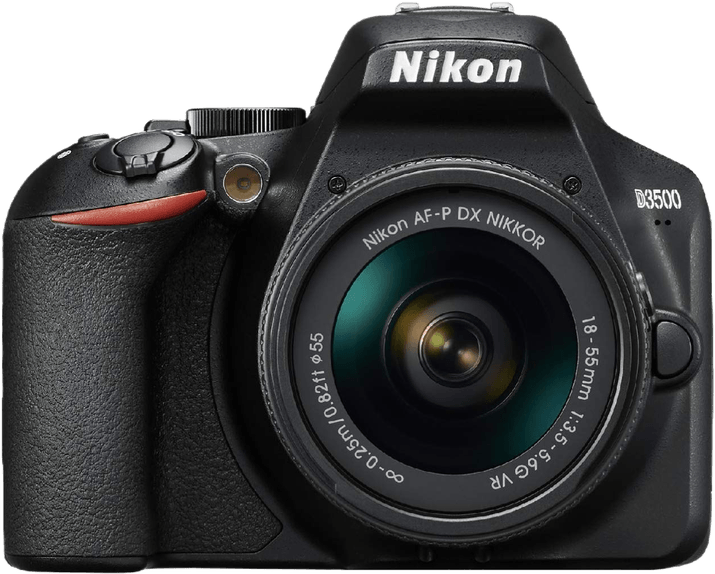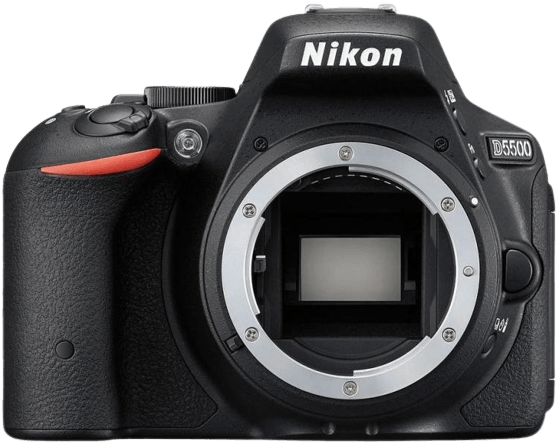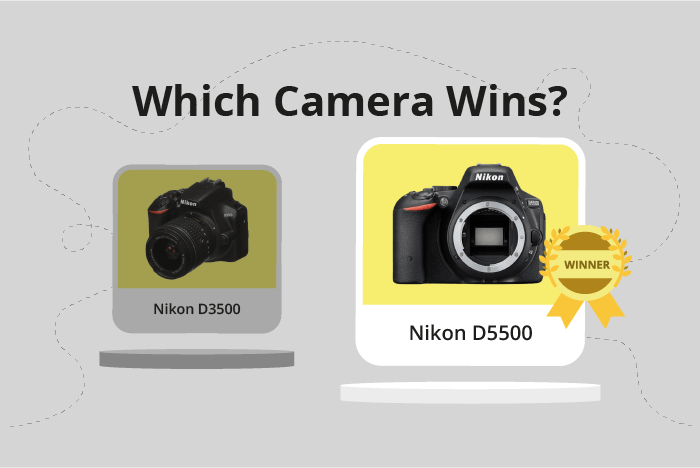Nikon D3500 vs D5500 Comparison
Nikon D3500

Nikon D5500

The Nikon D3500 and Nikon D5500 both score 61/100, making them evenly matched in our evaluation. These DSLR cameras share some common specifications, such as their camera type, size (124 x 97 x 70mm), and launch prices of $499.95 for the D3500 and $900 for the D5500.
However, the D5500 has a slight edge in terms of weight, coming in at 420g (0.93lbs), while the D3500 weighs 615g (1.36lbs). This makes the D5500 more portable and easier to carry around. On the other hand, the D3500 has the advantage of being a more recent release, as it was announced in 2018 compared to the D5500’s 2015 announcement date. This could mean that the D3500 benefits from more recent technological advancements.
Taking these factors into account, both cameras have their unique strengths, with the D5500 being lighter and the D3500 being a more recent model. Ultimately, the choice between the two depends on the individual’s preferences and priorities.
Nikon D3500 vs D5500 Overview and Optics
The Nikon D3500 and Nikon D5500 have identical scores of 65/100 for their optics. They share several common specifications, including a 24-megapixel count, a shooting speed of 5, a CMOS sensor type, an Expeed 4 processor, an APS-C sensor size, a Nikon F lens mount, and no image stabilization.
The Nikon D5500 has a slight edge in megapixels, with 24.2 compared to the D3500’s 24. This difference provides a marginal improvement in image resolution. However, the D3500 has a higher DXOMARK score for its sensor at 87, compared to the D5500’s 84. This means the D3500’s sensor performs better in terms of color depth, dynamic range, and low-light performance.
The Nikon D3500 is better in terms of sensor performance, which results in better image quality. Despite having a slightly lower megapixel count, the D3500’s higher DXOMARK score compensates for this difference, offering improved image quality overall.
On the other hand, the Nikon D5500’s slightly higher megapixel count can provide marginally better image resolution. However, this advantage is minimal and may not be noticeable in most shooting situations.
In comparing the optics of the Nikon D3500 and Nikon D5500, both cameras share many similarities, and their overall scores are identical. The D3500 has a better sensor performance, while the D5500 has a minor advantage in image resolution. Ultimately, the choice between these two cameras will depend on the individual photographer’s preferences and needs.
Nikon D3500 vs D5500 Video Performance
The Nikon D5500 emerges as the winner in the video capabilities comparison, with a score of 70 out of 100, while the Nikon D3500 scores 56 out of 100. Both cameras share some common specifications, such as Full HD max video resolution, max video dimensions of 1920×1080, and a max video frame rate of 60fps.
The D5500 outperforms the D3500 in video capabilities primarily due to its built-in time-lapse functionality. This feature allows users to create stunning time-lapse videos without needing additional software or equipment, making it a more versatile option for those interested in capturing the passage of time in their videos.
On the other hand, the D3500 does not offer any distinct advantages in video capabilities compared to the D5500. Its lower video score reflects the lack of time-lapse functionality, which may be a crucial feature for some users.
With these points in mind, it is clear that the Nikon D5500 offers superior video capabilities compared to the Nikon D3500. The built-in time-lapse functionality sets it apart and provides users with a valuable tool for creative video projects. While the D3500 may be sufficient for basic video needs, the D5500 stands out as the better choice for those looking to take their videography to the next level.
Nikon D3500 vs D5500 Features and Benefits
The Nikon D5500 emerges as the winner in the features category, scoring 59/100, while the Nikon D3500 scores 54/100. Both cameras share some common specifications, such as a 3-inch screen size, no GPS functionality, and the presence of Bluetooth connectivity.
The D5500 outperforms the D3500 in several aspects. It boasts a larger 3.2-inch screen size and a higher screen resolution of 1,037,000 dots compared to the D3500’s 921,600 dots, providing a clearer and more detailed display. Additionally, the D5500 features a touchscreen, which makes navigating menus and adjusting settings more convenient. This camera also has a flip screen, allowing for more flexible shooting angles and better composition. The presence of Wi-Fi connectivity in the D5500 enables easy sharing and transfer of images, a feature absent in the D3500.
On the other hand, the D3500 has a slight advantage over the D5500 in terms of Bluetooth connectivity. While both cameras have this feature, the D5500 lacks it, which may be a drawback for some users who prefer to use Bluetooth for transferring images or remote shooting.
Taking these points into consideration, it is evident that the Nikon D5500 offers better features than the D3500. Its larger screen size, higher screen resolution, touchscreen, flip screen, and Wi-Fi connectivity make it a more versatile and user-friendly camera. However, the D3500’s Bluetooth connectivity may still appeal to some users. In the end, choosing between these cameras will depend on individual preferences and the specific features required for one’s photography needs.
Nikon D3500 vs D5500 Storage and Battery
The Nikon D3500 outperforms the Nikon D5500 in storage and battery with a score of 48/100 compared to the D5500’s 35/100. Both cameras share common specifications, such as having a single memory card slot and accepting SD, SDHC, and SDXC cards. Neither camera offers USB charging.
The D3500’s superior battery life sets it apart, providing 1550 shots on a single charge using the EN-EL14a battery. In contrast, the D5500’s battery life reaches only 820 shots using the EN-EL14 battery. This significant difference in battery life makes the D3500 more reliable for extended shooting sessions.
Although the D5500’s storage and battery features are not as impressive as the D3500’s, it still offers decent performance for casual photographers. However, for those who prioritize longer battery life and better storage capabilities, the Nikon D3500 proves to be the better choice.
Alternatives to the Nikon D3500 and D5500
Are you still undecided about which camera is right for you? Have a look at these popular comparisons that feature the Nikon D3500 or the Nikon D5500:

